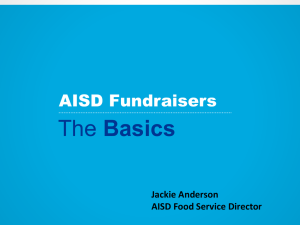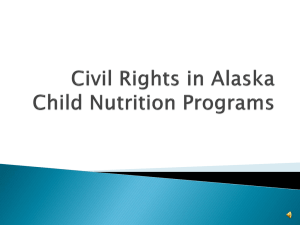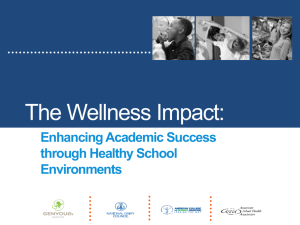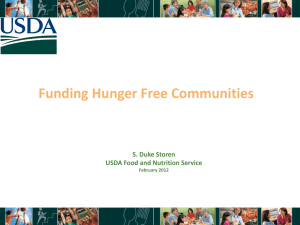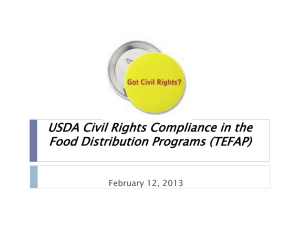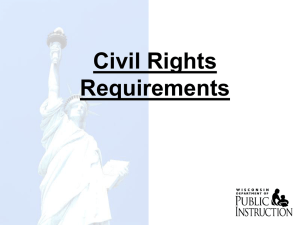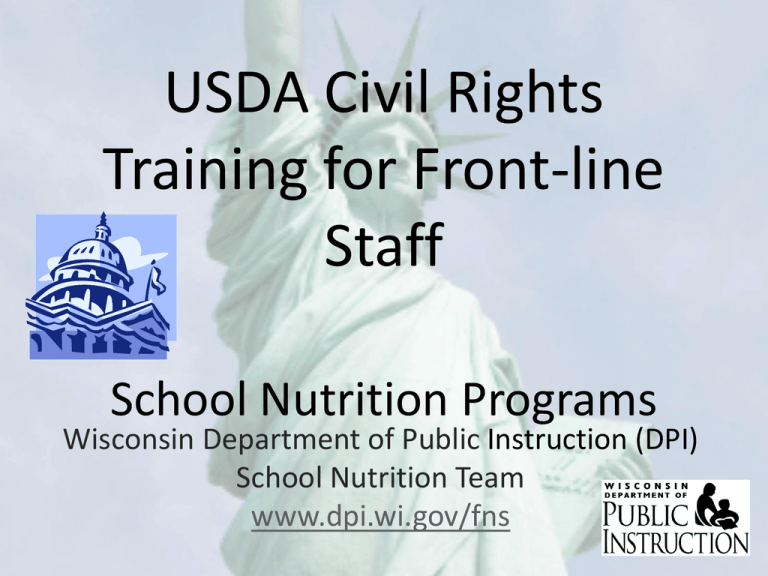
USDA Civil Rights
Training for Front-line
Staff
School Nutrition Programs
Wisconsin Department of Public Instruction (DPI)
School Nutrition Team
www.dpi.wi.gov/fns
Purpose of Civil Rights Training
• To inform, educate, and support all staff who
interact with Child Nutrition Program (CNP)
applicants:
– Staff rights and responsibilities as administrators
of CNPs
– General USDA Civil Rights requirements
– Resources and information available to assist staff
in carrying out their Civil Rights responsibilities
2
Federal Law prohibits discrimination
on the basis of these protected
classes:
• Race
• Sex
• Color
• Disability
• National Origin • Age
3
Protected Classes under Wisconsin
State Law
• Adds protections for persons with regard to religion,
creed, ancestry, pregnancy, marital status, parental
status, and sexual orientation
• Adopts all other Federal protected classes except for
color
• All Federal Child Nutrition Programs operating in public
school districts in the State of Wisconsin must adopt
both Federal and State protected classes (private
schools must only adopt Federal)
4
Notifying the Public of
Program Benefits and Requirements
5
Public Notification
PURPOSE:
• To inform surrounding area (especially underrepresented groups), that your school agency
participates in the CNPs
• To reach as many applicants, participants, and
potentially eligible persons as possible
– Potentially eligible: individual or household that
may be eligible to receive FNS program assistance,
benefits, or services, but have not applied
• To ensure program access
6
Public Notification
Must include information on:
• Eligibility
• Benefits & Services (i.e. free or reduced price school
meals and snacks)
• Program availability (location of local facilities or service
delivery points, hours of service)
• Applicant rights and responsibilities
• Procedures for filing a complaint
• Non-discrimination policies
• Any programmatic changes (i.e. changing location of a
meal site)
7
Methods of Public Notification
• Public Release (required)
– Inform the general public that your school participates in
the CNPs and that free and reduced price meals are
offered.
• Post “And Justice for All” Poster (required)
– Includes the USDA’s nondiscrimination statement and lists
the USDA contact information for filing a complaint of
discrimination.
• Other methods of public notification (optional)
– Bulletins
– Letters/Leaflets/Brochures
– Internet/Computer-based Applications
8
Public Release
The Wisconsin DPI requires a public release be submitted
by October 31 of each school year to:
The Media (examples: local/community newspapers, radio, television, the
Internet)
AND
Grassroots Organizations that reach minority or underrepresented groups (colleges, churches, refugee/immigrant
settlement services, Laundromats, social service agencies, employers
contemplating layoffs, libraries, grocery stores, WIC offices, food pantries,
senior centers, physician offices/clinics, Community Action Program
Agencies)
9
Public Release
• Example of a public release available on DPI’s
website http://www.dpi.wi.gov/fns/fincou1.html
– Enter your site information (contact name,
address, etc) and print
• Agencies are not required to pay to have the public
release published, but it must be submitted with
the intent to have it published
• Keep documentation on file of where information
was sent the and the date it was submitted
10
“And Justice for All” Poster
• All agencies participating in
Child Nutrition Programs must
display the USDA’s nondiscrimination poster in a
prominent area where
participants and potential
participants have access
– Examples: cafeteria/food service
area, Child Nutrition Office
• Must be posted at every food
service/preparation site
• Must be 11” x 17” format
11
Obtaining “And Justice For All”
Posters
• "And Justice for All" poster is available to
download from the USDA website for
temporary use:
http://www.fns.usda.gov/cr/justice.htm
• DPI provides posters to schools free of charge.
To order posters for permanent use call
608-267-9228
12
Non-Discrimination Statement
A USDA required non-discrimination statement must be
included on ALL forms of communication and program
materials related to receipt of free or reduced-price
Child Nutrition Program benefits, including all materials
for public information, education, or distribution that
mention USDA programs.
State of WI non-discrimination statement is not required
to be posted.
13
Required Non-Discrimination
Statement Language
The U.S Department of Agriculture prohibits discrimination against its customers, employees, and
applicants for employment on the bases of race, color, national origin, age, disability, sex, gender
identity, religion, reprisal, and where applicable, political beliefs, marital status, familial or
parental status, sexual orientation, or all or part of an individual’s income is derived from any
public assistance program, or protected genetic information in employment or in any program or
activity conducted or funded by the Department. (Not all prohibited bases will apply to all
programs and/or employment activities.)
If you wish to file a Civil Rights program complaint of discrimination, complete the USDA Program
Discrimination Complaint Form, found online at
http://www.ascr.usda.gov/complaint_filing_cust.html, or at any USDA office, or call (866) 6329992 to request the form. You may also write a letter containing all of the information requested
in the form. Send your completed complaint form or letter to us by mail at U.S. Department of
Agriculture, Director, Office of Adjudication, 1400 Independence Avenue, S.W., Washington, D.C.
20250-9410, by fax (202) 690-7442 or email at program.intake@usda.gov.
Individuals who are deaf, hard of hearing or have speech disabilities may contact USDA through
the Federal Relay Service at (800) 877-8339; or (800) 845-6136 (Spanish).
USDA is an equal opportunity provider and employer.
14
Required Non-Discrimination
Statement Language
If the material or document is too small to
permit the full statement (above) to be
included, the material MUST, at a minimum,
include:
“USDA is an equal opportunity provider and
employer.”
15
Non-Discrimination Statement
• Wording for either statement must be exact
and cannot be changed in any way
• Print size for either statement shall be no
smaller than the text of the material
• Shorter version of non-discrimination
statement may be used for broadcast
advertisements/public service
announcements
16
Examples of Informational Materials
that Require the Non-Discrimination
Statement
• Print Advertisements
– Flyers
– Brochures
– Posters
• Agency Publications
– Parent/Student Handbooks
– Employee Handbooks
– Newsletters
• School Websites
• Letters
• Broadcast
Advertisements/Public
Service Announcements
– Internet
– Radio
– TV
• Enrollment Forms
• Menus (if public receives
copies)
**Not required to be printed on items such as cups, buttons, magnets, pens, etc.
due to impractical size
17
Other Things to Consider…
To convey the message of equal opportunity—
reflect diversity and inclusion in all program or
program-related information, photos and
graphics.
18
Customer Service
19
Customer Service
• All students must be allowed equal opportunities to
participate in CN programs regardless of race, color,
national origin, sex, age, disability, or other State
protected classes
• All participants must be treated in the same manner
(i.e. seating arrangements, serving lines, services and
facilities, assignment of eating periods, methods of
selection for application approval and verification
processes)
20
Meal Service
All persons must:
• Be included in meal and snack service, activities, and
discussions
•
Receive equally positive comments, as well as constructive
education regarding meal time, nutrition, manners, etc.
• Be held to standards of behavior that are not based on
Federal and State protected classes (race, color, religion,
etc.)
For example: Students of a certain race or color are expected to behave
to the same standards as students of another race or color
21
Meal Service
Children must not be required to use a separate dining
room, separate serving line, or separate serving time
based on eligibility for free/reduced meals, sex,
national origin, race/color, etc.
Examples:
• Students of about the same age are given about the same time
to eat
• Students whose first language is Spanish are not required to sit
at a “Spanish-speaking” table for meals
• Boys are not seated at separate tables from girls (this is implied
segregation and questionable unless done for disciplinary or
legitimate reasons)
22
Meal Service
All students within the same grade grouping must be offered
the same selection of menu items in the same amounts
regardless of their eligibility, sex, national origin, race/color,
etc., including when a school offers :
• A selection of more than one type of meal that is claimed for
reimbursement
• A variety of foods and fluid milk for choice within the meal requirements
Examples:
• Boys and girls in the same grade are offered the same food, in the same
amounts
• Leftovers at the end of the lunch period are offered to everyone (i.e. not just the
boys, etc.)
• Certain items are “saved “for all students, not just for specific students
23
Denial of Meals
USDA policy prohibits the denial of meals as a disciplinary action
against any student who is enrolled in a school that participates in the
Child Nutrition Programs, including:
• Disciplinary actions that directly result in loss or denial of meals
• Requiring a child to work for his/her meals
The following are circumstances where meals may be denied.
• Disciplinary actions that indirectly result in loss of meals (i.e. student
is suspended from school)
• Schools are not required to serve children who receive reduced- or
full-price meals but do not have money to pay, however:
– It is recommended that schools establish policies to handle such
situations and inform parents/students of limitations of policy
– Each school is free to decide whether to institute negative
balance limits or provide alternative meals/food items for these
students
24
F/R Application Approval Process
• Denied F/R applications shall not be
disproportionately composed of minority
groups
• Admission procedures must not restrict
minority persons from enrolling in school or
participating in the meal/snack programs
• Students may not be required to participate in
the Child Nutrition Programs
25
Confidentiality: Information Provided
on F/R Applications
The USDA authorizes schools to release only
student F/R eligibility status to entities as stated
in the Eligibility Manual for School Meals (page
53)
-In many cases a household waiver of confidentiality may be
required!
NO OTHER INFORMATION ON APPLICATION
MAY BE RELEASED!
26
Schools must ensure that a written
household waiver is on file and:
• Clearly informs households of the waiver’s
purpose
• Authorizes release of free and reduced-price
eligibility information
• Identifies how the information will be used
• Identifies who will use the information
• Is signed by parent or guardian (note: schools
are not responsible for verifying authenticity
of parent/guardian signatures)
27
Confidentiality of F/R Eligibility
• Names, or other forms of identifying information, of children must
not be published, posted, or announced in any manner. Identifying
information must not be used for any purpose other than
determining and verifying eligibility for F/R meals
• Overt identification of any of the children by use of special tickets
or tokens is prohibited
– Agency must use collection procedures that have been approved via
the online contract
• No overt identification may be used when ordering meals for
special functions (field trips, class parties)
– Examples: students raising hands, forms sent home that identify
eligibility
28
Understanding Differences: Respectful Language
Put the person first
Example: USE “person with a disability”, NOT “disabled person”
http://www.kencrest.org/people_first_language.htm?gclid=CPPS9Zu2kpwCFSQe
DQodKghFfA
Use culturally sensitive language
Example: USE “Asian”, NOT “Oriental”
http://www.sideroad.com/Business_Communication/politically-correctlanguage.html
Use inclusive/respectful terms
Example: USE “chairperson”, NOT “chairman”
29
Ask yourself each time you
interact with participants…
• How would I want to be addressed?
• Am I treating this person in the same manner I treat
others?
• Have I informed this person exactly what information
I need to make a determination on the application?
• Have I given this person the opportunity to clarify all
relevant factors or inconsistencies and ask
questions?
• Have I provided this person with information (s)he
needs to make necessary decisions?
30
Language Assistance
31
LEP Language Assistance
All organizations receiving Federal financial assistance
via participation in Child Nutrition Programs have a
responsibility to take “reasonable steps” to ensure
meaningful access to their programs and activities by
persons with Limited English Proficiency (LEP).
Limited English Proficiency (LEP): Individuals who do
not speak English as their primary language and who
have a limited ability to read, speak, write, or
understand English.
32
Primary factors to consider when determining
“reasonable steps”
• Number and proportion of LEP persons served or
encountered in eligible population
– The greater the number = the higher the need
• Frequency with which LEP individuals come in
contact with program
• Nature and importance of program, activity, or
service
– Will denial of service cause a serious or life-threatening implication for
potential participants?
• Resources available to the recipient/costs
– Accessibility of a translator for applications, etc.
– Availability of materials in various languages
33
Language Translations for Program
Materials
• Make Child Nutrition Program information available to all
persons in their language
– Provide informational materials in the appropriate translation
concerning the availability and nutritional benefits of the meal programs
• English, Spanish, and Hmong versions of household
applications are available on WDPI’s website
http://www.dpi.wi.gov/fns/fincou1.html
– Household applications in 34 other languages can be found at
http://www.fns.usda.gov/cnd/Application/familyfriendlyapps.html
**Please note: Wisconsin modifies the USDA application slightly each year
based on programs offered in Wisconsin. Thus, if you choose to use a USDA
application, it is recommended that you compare it to the English version on
DPI’s website to ensure that you have all necessary information listed
34
Language Interpreters
• Children should not be used as interpreters
• Volunteers may be used, but should
understand ethics for using interpreters
– Example: Spanish teacher could assist a
household in completing an application but would
need to be trained on the importance of keeping
all information received from the household
confidential
• See www.lep.gov for more information and
resources
35
A shortage of resources does not
eliminate the translation requirement
Suggestions:
Share resources to save money
• Use interpreter from another area
• Train bilingual staff to be interpreters
• Contact grassroots organizations to discuss translation or
assistance from within the community
Language line phone services may be available for a
subscription fee through your local telephone
service provider
36
Suggestions for Providing
Assistance to Populations with
Literacy Concerns
• Inform adult household members known to
have literacy deficiencies of program benefits
verbally
• Enlist a staff member to assist applicants with
literacy concerns in completing F/R meal
applications
37
Reasonable Accommodation of
Persons with Disabilities
38
What is a disability?
Definition: physical or mental impairment which substantially
limits one or more of an individual’s major life activities, has a
record of such and impairment, or is regarded as having such
an impairment
Disabilities are defined based on the Sect 504 of the
Rehabilitation Act/Americans with Disabilities Act and Part B of
Individuals with Disabilities Education Act (IDEA)
- Examples: Orthopedic/visual/speech/hearing impairments, cerebral
palsy, epilepsy, muscular dystrophy, multiple sclerosis, cancer, specific
learning disabilities, tuberculosis, diabetes, phenylketonuria, heart
condition, food anaphylaxis, mental retardation, emotional illness, drug
addiction/alcoholism, HIV, autism, traumatic brain injury
39
What is school’s responsibility to
children with disabilities?
• Provide facilities for participants with disabilities
– Example: accessible parking lots, entrances and exits, halls, elevators,
rest rooms, service animals, Braille signage, alternative arrangements
for service
• Provide appropriate information in alternative
formats for persons with disabilities
– Example: Braille program materials, sign language interpreters
• Provide food substitutions for students with
disabilities when documented in writing by a
licensed physician
40
Providing Menu Item Substitutions
• USDA regulations only require substitutions or modifications in
school meals for children whose disabilities restrict their diets
based on a licensed physician’s assessment
Example: food allergies causing life-threatening anaphylactic reactions
• Disabilities must be documented by a physician’s statement
Physician statement must: state the name of the child’s disability, identify how it limits
one of the major life activities, specify foods the child cannot have and the foods to be
substituted.
• Generally, children with food allergies or intolerances do not
have a disability. The school food service may, but is not
required to, make food substitutions under these circumstances
Example: lactose intolerance, sensitivity to food additives
• USDA has special rules that apply to milk substitutions (See
recent USDA policy memos SP 02-2009, 35-2009, & 07-2010 for
41
details)
Resources
Available on DPI’s website:
USDA Guidance: “Accommodating Children with Special
Dietary Needs in the School Nutrition Programs”
Prototype Physician Form
http://fns.dpi.wi.gov/fns_market1
USDA Fluid Milk Substitution Rule Policy Memo: 07-2010
http://www.fns.usda.gov/cnd/governance/policy2006-2011.htm
WI Services for Deaf and Hearing Impaired Students
http://sped.dpi.wi.gov/sped_hi_deaf
42
Racial/Ethnic Data Collection
43
Why do I have to collect
racial and ethnic data?
Racial/ethnic data is used to determine how
effectively your program is reaching potentially
eligible children and where outreach may be
needed.
44
Collecting and Recording
Participation Data
• Establish a system to collect racial and ethnic data
• Data must be reported on an annual basis
• Program applicants may not be required to furnish
ethnicity and race
– You may inform the household, however, that collection of this
information is strictly for statistical reporting and has no influence on
eligibility determination for the program.
• Data collectors may not second guess, change, or
challenge a self-declaration of ethnicity/race made by a
participant unless such declarations are blatantly false
45
Two Question Format for
Collecting Data
Collect ethnic data first, then racial data
1. Ethnicity categories:
– Hispanic or Latino
– Non-Hispanic or Non-Latino
2. Racial categories (instructions should specify “mark
one or more”)
–
–
–
–
–
American Indian or Alaskan Native
Asian
Black or African American
Native Hawaiian or other Pacific Islander
White
46
Obtain racial/ethnic data through
• Voluntary self-identification or self-reporting
(preferred method)
F/R meal application: Household applications that are completed
each year and submitted to the school have a section for the
household to identify their racial and ethnic data (households are
not required to complete this)
• If a household chooses not to provide racial/ethnic
information, you may use one of the following two
methods:
– Visual identification by a school official
– Personal knowledge, records or other documentation your
agency possesses that identifies household racial/ethnic data.
47
Data Management
• Collection systems must ensure that data
collected/retained are:
– Collected and retained by each program site
– Based on documented records
– Maintained under safeguards that restrict access to
personal records to only authorized personnel (i.e. data
should be kept secure and confidential)
– Submitted, if requested, to FNS Regional or Headquarters
Offices
– Kept on file for 3 years plus the current program year
– Identify all sources of information used
48
Conflict Resolution
49
Conflict Resolution
• The USDA recommends using an Alternative
Dispute Resolution (ADR) program
ADR Definition: use of a neutral third party (usually
a person acting as a facilitator) to resolve informally
a complaint of discrimination through use of various
techniques such as fact finding, mediation, peer
panels, facilitation, ombudsman support, or
conciliation.
Visit http://www.fas.usda.gov/Admin/civilrights/conflictres.asp
for more information.
50
Complaint Procedures
51
Complaint Information
Applicants and participants must be advised of:
•
Their right to file a complaint
•
How to file a complaint
–
•
Public Release and “And Justice for All” poster assist
in disseminating this information
Complaint procedures
52
Right to File a Complaint
Any person who believes he or she or someone he/she knows
has been discriminated against based on Federal or State
protected classes (i.e. National origin, race, etc.) has a right to
file a complaint within 180 days of the alleged discriminatory
action.
Complainants may contact any of the following offices to register
a complaint:
1.
USDA: U. S. Department of Agriculture, Director, Office of Adjudication,
1400 Independence Avenue, SW, Washington, DC 20250-9410, (866) 6329992 (toll free), (202) 260-1026, (202) 401-0216 (TDD).
2.
Wisconsin DPI: Director, School Nutrition Programs, 125 South Webster
Street, P.O. Box 7841, Madison, WI 53707-7841, (608) 267-9121
53
Forms of Civil Rights Complaints
• May be written, verbal, or observed
– If receiving a verbal complaint, listen politely
– Complaints can be made via phone, letter, email, fax or any
other form of communication
• May be anonymous
– Anonymous complaints should be handled as any other
complaint
• Can be related to any area of CNP operation
– Program administration, food service, employment
54
Handling Civil Rights Complaints
STEP 1: Document the Complaint
Make an effort to obtain all of the following information:
– Name, address, and phone number of complainant (when possible,
but not required).
– Specific name and location of entity delivering the benefit or service.
– The nature of the incident, action, or method of administration that
led the complainant to feel discriminated against.
– The basis on which the complainant feels discrimination exists (race,
color, national origin, sex, etc.).
– The names, titles, business addresses, and phone numbers of persons
who may have knowledge of the discriminatory action.
– The date(s) during which the alleged discriminatory actions occurred,
or if continuing, the duration of such actions.
55
STEP 2: Contact USDA
All verbal or written complaints must be
forwarded to the Civil Rights Division of USDA
Food and Nutrition Service within three days of
receiving a complaint
56
Step 3: Maintain Records
• Have a central location where copies of Civil Rights
complaints will be documented and kept
– Agencies should consider documenting all complaints in
Complaint Log or on Complaint Forms
• Agencies may provide complaint form to:
– Any individual wishing to make a complaint
– Person receiving verbal or phone complaint
57
Civil Rights Compliance Reviews
& Resolutions of Non-Compliance
58
Civil Rights Monitoring Form
Purpose: To provide a tool for agencies to selfevaluate activities and determine adherence
with civil rights requirements.
• This form must be completed and kept on file
every year by October 31
– Form is available on DPI’s website at
http://fns.dpi.wi.gov/fns_market1#cr
Listed as: School Food Authority-Civil Rights Compliance
Self Evaluation Form-National School Lunch Program
Resolution of Non-Compliance
Non-Compliance: a factual finding that any Civil Rights
requirement, as provided by law, regulation, policy,
instruction, or guidelines is not being adhered to.
There are no “minor” or “major” categories of
noncompliance. All instances of non-compliance are
considered equally.
– No matter the level or severity of noncompliance, it must
be reported.
60
Examples of Non-compliance
• Denying an individual or household the opportunity to apply for FNS
program benefits or services on the basis of Federal or State protected
classes (race, color, national origin, age, etc.)
•
Providing FNS program services or benefits in a dissimilar manner on the
basis of race, color, national origin, age, or sex. Example: Serving lunch to
an African American child but serving a snack/modified meal to an Asian American
child.
• Selecting FNS program sites or facilities in a manner that denies an
individual access to FNS program benefits, assistance, or services on the
basis of Federal or State protected classes (race, color, national origin,
etc.) Example: Serving breakfast in some schools, but not at schools located in
areas with a high proportion of children with disabilities or a high proportion of
minority students.
61
Resolution of Non-Compliance
If non-compliance is indicated, a corrective
action plan must be implemented immediately
to achieve voluntary compliance within 60 days.
Corrective Action Plan: plan describing the
agency’s actions to be taken to resolve noncompliance with civil rights requirements.
62
Civil Rights Coordinator
within Your School
Agencies must designate an employee who is
responsible for USDA Civil Rights issues, and:
– This individual must be designated to receive
complaints
– This individual should be identified to all
employees
– The designated person should know who to
contact if Civil Rights issues arise
63
Wisconsin Department of Public Instruction
School Nutrition Team
125 South Webster Street
P.O. Box 7841
Madison, WI 53707-7841
608-267-9228
www.dpi.wi.gov/fns
**Parts of this presentation have been adapted from several states, including Iowa, Illinois, Indiana,
Missouri, and Texas.
64
Employees: Please sign off on
receiving this information.
65

